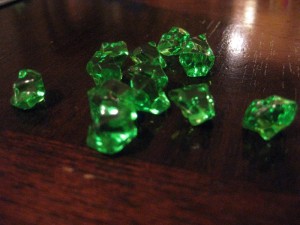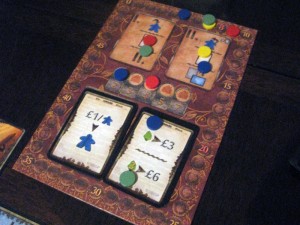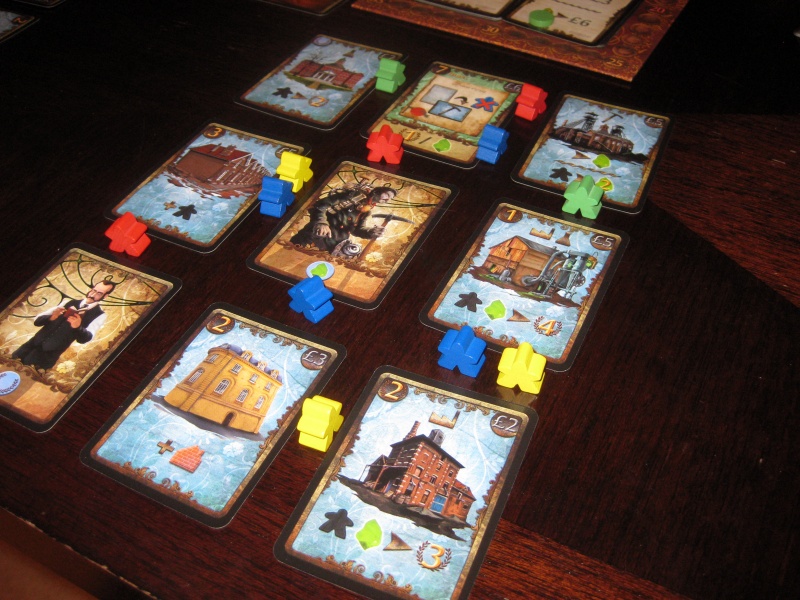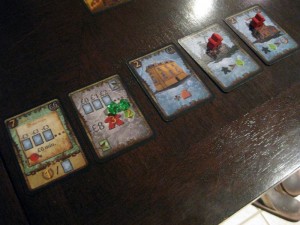 In recent years, steampunk has become more and more known in popular culture; with literature, fashion, media and crafts being inspired by the ideas behind the subgenre. This year, many games were released with a steampunk theme, but none more anticipated than Spyrium, by William Attia, designer of the award-winning Caylus. Is this steampunk-inspired Euro strong enough to start your engine, or will it leave you grinding your gears? Keep reading to find out!
In recent years, steampunk has become more and more known in popular culture; with literature, fashion, media and crafts being inspired by the ideas behind the subgenre. This year, many games were released with a steampunk theme, but none more anticipated than Spyrium, by William Attia, designer of the award-winning Caylus. Is this steampunk-inspired Euro strong enough to start your engine, or will it leave you grinding your gears? Keep reading to find out!
Spyrium is a worker placement and economy management game for 2-5 players that plays in 60-90 minutes. Spyrium plays best with 3-4 players.
Game Overview:
Spyrium places you in England in an alternate timeline where a new element called ‘spyrium’ is discovered and considered of high value. Your role is that of a mogul looking to build up an economic engine that earns money, produce spyrium, and refines it into victory points. This is accomplished through the placement of workers to hire specialists and to purchase buildings and techniques which give you extra options for worker actions in later rounds. The game ends after 6 rounds, where the player with the most victory points, through the refining of spyrium and bonus points from buildings and techniques, is declared the winner.
Components:

The quality of the components in Spyrium are of the quality standard that one comes to expect from an Asmodee production. Wooden meeples, cardboard coins and markers are of standard quality, and the green translucent spyrium crystals are definitely pleasing to the eye. There is also a small central board for tracking points and actions that is well made.
The artwork and graphic design of the cards in the game are both a blessing and a curse. The artwork is beautifully drawn and is truly evocative of the theme and setting that the game is attempting to convey. The iconography on the buildings and the specialists are relatively straightforward, with their function clear most of the time. This does not hold, however, with the technique cards, which have more complicated functions and icons that do not necessarily communicate their function as effectively. Without any game text on the cards, we found ourselves continually referring back to the rulebook to confirm just what those cards did. Another major fault in the graphic design of all the cards is the fact that nowhere on the cards is there the actual name of the card. It does a disservice to both theme and ease of gameplay without that basic information present.
How to Play:
The game takes place over 6 rounds, each of which are divided into two phases: the placement phase and the activation phase. At the beginning of each round, players get revenue and that round’s event (drawn randomly from a small set) is made available for action selection by the players. The market, which serves as the “board,” is created by drawing a random set of 9 cards and arranging them in a 3×3 grid with spaces in between. These sets are each drawn from three different decks, depending on the round the game is in.

In the market, there are three different types of cards: characters, buildings and techniques. Character cards provide a one-time ability, but can be used up before all players take advantage of them. Buildings are purchased by players and added to their play area, providing them with more actions to produce spyrium and income, earn victory points, as well as gaining more workers to place. Technique cards (of which there are a very small amount) are purchased by players and provide special powers and bonus points at the end of play.
During the placement phase, players take turns placing their workers in the market. Unlike in other games where workers are placed on a single action, workers are placed between two of the cards in the market, making either of them available for access by that worker when it is activated. When placing workers, players need to keep in mind that the number of workers adjacent to a card impacts the cost to activate the card later, so placement can be used to drive up the cost of cards you know your opponents plan on activating. In addition to worker placement, players can choose to activate the power granted by the turn’s event.
The transition between the placement phase and the activation phase is based on each individual player’s choice of when that occurs. It is possible for all players to transition at the same time, and it is possible for some players to be activating their workers while others are still placing theirs. This choice of when to transition between phases can be dependent on an individual player’s strategy, as well as game conditions such as market makeup and the round number.
During the activation phase, more actions open up to the players. Players can activate their workers by removing them and activating the adjacent card by paying the card’s cost plus the number of meeples remaining adjacent. Players can use any unplaced workers to activate their building’s powers, producing, selling and refining spyrium into income and points. In addition, players can earn income by simply removing a worker from the market and collecting money based on remaining workers near that worker. If the circumstances arise that there are absolutely no actions available, players can pass.
Play continues until all players have activated all their workers or passed, which causes the end of the round. After six rounds, the game ends. Points are totaled up and bonus points are awarded. The player with the most points is the winner.

Game Experience:
Spyrium takes the traditional worker-placement mechanic found in many games and adds some interesting twists to make it a unique experience. By having two possible actions based on the placement of a worker, this gives players both flexibility and the ability to be somewhat sneaky in developing their overall plan. The additional cost to cards based on the number of surrounding workers also adds another element of strategy in placement. In some cases, a worker can be placed to help further your own agenda while driving up the cost of a card you know your opponents are targeting. In the event that your opponents try the same tactic against you, being able to earn money based on the number of nearby workers is a nice counter balance. As opposed to other games in the genre, where you place your worker has much more impact on the game than simply taking up an action space.
A unique aspect to Spyrium is the player choice in phase transition. Many games have a specific and set flow from one phase to the next, with all players going through each phase in sequence at the same time. Knowing when to move between placement and activation becomes integral to player strategy. To be able to take advantage of characters and buy technique cards before your opponent has the chance to was an interesting game mechanic.

A big part of the appeal of Spyrium is creating and implementing an engine for acquiring spyrium and turning it into income and victory points. The early rounds require you to set up your methods through buildings and techniques, giving you the opportunity in the later rounds to activate your buildings and process your spyrium into points. Buying technique cards that augment and support your engine help create situations where a huge amount of points and money can be produced through your economic engine.
The theme of the game is very well-imagined and interesting, but it has absolutely no impact or effect on the game play. This game could have you making and selling literally anything (candles, watermelons, chain mail) you pasted on, which is a shame since the mechanics are so neat. I was quite disappointed that the theme wasn’t as prevalent in the game play.
The number of players is important to take into account when assessing the quality of Spyrium. With two players, the strategic aspects of worker placement are severely downplayed, as it is very easy to work on different ends of the market with no overlap. With four players, interaction between players’ plans becomes inevitable and provides the requirement of having a plan and being able to adapt based on other players’ actions. While the game states that it plays with 2-5 players, it really works best with four.
Final Thoughts:
If you like worker placement games and you’re looking for a title that adds a good spin to the traditional mechanic, then Spyrium might be for you. If you’re a strictly two-player household, then Spyrium probably isn’t the best choice for you. An either case, Spyrium is a new and interesting entry into the worker placement genre. I do wish the theme was more than skin deep on this one, but the mechanics really help to make this one work for me. Give it a try and see what you think.
If you are interested in getting a copy for yourself, it’s about $26
Final Score: 4 Stars – Solid and straightforward. Buy it for the mechanics, not the theme.
 Hits
Hits
• New aspects to the worker placement genre adds deeper strategy
• Novel phase transition based on player choice
• Game play is easy to pick up
• Plays quickly once you master the rules
Misses
• Good theme, but completely pasted on, with no impact on game play
• Poor design with lack of game text on cards & difficult-to-read iconography on technique cards
• Limited range of players to provide quality game play




















